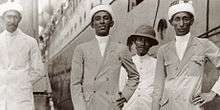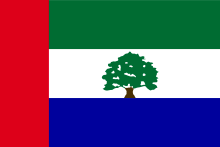Hadhrami people
| الحضارم | |
|---|---|
 Hadhrami immigrants in Surabaya, 1920 | |
| Regions with significant populations | |
| Languages | |
| Hadhrami Arabic, Urdu, Sylheti Bangla, Tamil (South India), Malay (Brunei, Indonesia, Malaysia and Singapore), Swahili (Kenya), Somali (Somalia). | |
| Religion | |
| Islam (Sunni Shafi'i, strong Sufi-orientation), Judaism, Christianity, Paganism. | |
| Related ethnic groups | |
| Arabs, Arab diaspora, Arab Singaporeans, Arab Malaysians, Arab Indonesians, Chaush, Arabs in India, Sri Lankan Moors, Hyderabadi Muslims. |

The Hadhrami (Arabic: حضرمي, sing.) or Hadharem (الحضارم, pl.) are people inhabiting the Hadhramaut region in Yemen and their descendants in diaspora communities around the world. They speak Hadhrami Arabic, which belongs to the Semitic branch of the Afro-Asiatic family.
Among the two million inhabitants of Hadhramaut, there are 1,300 distinct tribes.
Diaspora
The Hadharem have a long seafaring and trading tradition. Hadhrami seamen have navigated in large numbers all around the Indian Ocean basin, from the Horn of Africa to the Swahili Coast to the Malabar Coast and Hyderabad in South India, Sri Lanka to Maritime Southeast Asia.[1] They were involved in many places as organizers of the Haj.
There are Hadharem communities in the trading ports of the Arab States of the Persian Gulf and the Red Sea. The money changers in Jeddah, Saudi Arabia have usually been of Hadhrami origin.[2]
The Hadhrami have long had a notable presence in the African Horn region (Djibouti, Eritrea, Ethiopia and Somalia). Hadhrami settlers were instrumental in helping to consolidate the Muslim community in the coastal Benadir province of Somalia, in particular.[3] During the colonial period, disgruntled Hadhrami from the tribal wars additionally settled in various Somali towns.[4] They were also frequently recruited into the armies of the Somali Sultanates.[5]
Some Hadhrami communities also reportedly exist in Mozambique and Madagascar.[6]
Hadhrami Jews
The vast majority of the Hadhrami Jews now live in Israel.[7]
Language
The Hadhrami speak Arabic, a Semitic branch of the Afro-Asiatic family, while the Diasporas that have acculturated mainly speak the local language they live in.
Diaspora communities
- Sri Lankan Moors[8]
- Arab Indonesian
- Arab Malaysian
- Arab Singaporean
- Chaush, India
- Sodagar (Gujarati Shaikh)
- Labbay
- Hadrami Jews in Israel and abroad
- Lemba people who claim Jewish ancestry via Hadramaut's historic Jewish population
- Nawayath, Barkas, Hyderabad, India
Hadhrami people
Swahili Coast
- Awadh Saleh Sherman, Kenya, businessman
- Najib Balala, Kenya, Member of Parliament
- Ahmed Abdallah Mohamed Sambi, President of Comoros
- Habib Salih, Lamu, Kenya, religious scholar
North Africa
- Artega tribe, Babkeer, Sudan
Horn of Africa
- Mohammed Al Amoudi, Ethiopia, businessman
Indonesia
- Abdurrahman Baswedan, journalist
- Abu Bakar Bashir, founder of Jamaah Islamiyah
- Ali Alatas, former Foreign Minister
- Alwi Shihab, former Foreign Minister, special envoy to Middle-east and OIC[9]
- Anies Baswedan, scholar, former Education Minister, Governor of Jakarta (2017-)
- Fadel Muhammad al-Haddar, former minister of maritime affairs and fisheries
- Fuad Hassan, minister of education and culture
- Hamid Algadri, a figure in Indonesian National Revolution and member of parliament
- Habib Abdoe'r Rahman Alzahier, religious leader
- Habib Ali al-Habshi of Kwitang, religious leader
- Habib Munzir Al-Musawa, Islamic cleric
- Habib Rizieq Shihab, founder of FPI
- Habib Usman bin Yahya, Mufti of Batavia
- Jafar Umar Thalib, founder of Laskar Jihad
- Sultan Badaruddin II, sultan of Palembang
- Munir Said Thalib Al-Kathiri, human rights activist
- Nuruddin ar-Raniri, Islamic scholar
- Quraish Shihab, Islamic scholar
- Raden Saleh, Artist/painter
- Said Naum, a philanthropist
- Sunan Ampel, Sufi saint
- Sayyid Abdullah Al-Aidarus, religious leader
East Timor
- Mari Alkatiri, former Prime Minister
Malaysia
- Habib Alwi bin Thahir al-Haddad, Mufti of Johor Bahru
- Syed Muhammad Naquib al-Attas, philosopher
- Syed Hussein Alatas, politician and sociologist
- Abdullah bin Abdul Kadir, writer
- Syed Hamid Albar, politician
- Syed Jaafar Albar, politician
- Syed Sheh Hassan Barakbah, judge
- Syarif Masahor, warrior
- Syed Mokhtar Al-Bukhary businessman
- Syed Nasir Ismail, politician
- Tun Habib Abdul Majid, Grand Vizier
- Zeti Akhtar Aziz, Governor of Central Bank
- House of Jamalullail (Perak)
- House of Jamalullail (Perlis)
Singapore
- Syed Mohamed Alsagoff, merchant
- Syed Mohamed Syed Ahmad Alsagoff, military leader
- Syed Sharif Omar bin Ali Al Junied, merchant and namesake of Aljunied Road[10]
South Asia
- General El Edroos
- Shaik Salman Bin Abdul Jabbar Bawazeer, A.C Guards, Hyderabad, India
- Sulaiman Areeb, Hyderabad, India, poet
- Awaz Sayeed, Hyderabad, India, Urdu writer and poet
- Ahmed Abdullah Masdoosi, Pakistan
- Nuruddin ar-Raniri, Islamic scholar
- Shah Jalal, Bangladesh, Sufi saint
- Shah Paran, Bangladesh, Sufi saint
- Subhani ba Yunus, Pakistan, actor
Saudi Arabia
- bin Laden family
- Mohammed Al Amoudi, businessman
Yemen
- Abd Al-Rahman Ali Al-Jifri, politician
- Abdulaziz Al-Saqqaf, human-rights activist
- Faisal Bin Shamlan, politician
- Habib Ali al-Jifri, Islamic scholar
- Habib Umar bin Hafiz, Islamic scholar
- Habib Abdullah bin Alwi al-Haddad, Sufi saint
- Imam Muhammad al-Faqih Muqaddam, founder of Ba'alawi Sufi order
- Sayyid Abu Bakr Al-Aidarus (saint)
See also
Notes
- ↑ Ho, Engseng (2006). The graves of Tarim: Genealogy and mobility across the Indian Ocean. University of California Press. ISBN 9780520244535. OCLC 123768411.
- ↑ Seznec, Jean-François (1987). The financial markets of the Arabian Gulf. Croom Helm. ISBN 9780709954040. OCLC 18558231.
- ↑ Cassanelli, Lee V. (1973). The Benaadir Past: Essays in Southern Somali History. University of Wisconsin--Madison. p. 24.
- ↑ Gavin, R. J. (1975). Aden under British rule, 1839–1967. London, UK: Hurst. p. 198. ISBN 0-903983-14-1.
- ↑ Metz, Helen Chapin, ed. (1993). Somalia: A country study (4th ed.). Washington, D.C.: The Division. p. 10. ISBN 9780844407753. LCCN 93016246. OCLC 27642849.
- ↑ Le Guennec, Francoise (1997). "Changing Patterns of Hadrahmi Migration and Social Integration in East Africa". In Freitag, Ulrike; Clarence-Smith, William G. Hadhrami Traders, Scholars and Statesmen in the Indian Ocean, 1750s to 1960s. BRILL. p. 165. ISBN 9004107711.
- ↑ Katz, Joseph. "The Jewish Kingdoms of Arabia". www.eretzyisroel.org. Retrieved 2017-06-25.
- ↑ "WWW Virtual Library: From where did the Moors come?". www.lankalibrary.com. Retrieved 2017-06-25.
- ↑ "IDBG President Receives Indonesia's Special Envoy". Retrieved April 20, 2017.
- ↑ "Arab trader's role in Singapore landmark". The Straits Times. 24 September 2015. Retrieved 5 July 2016.
References
Further reading
- AHMED BIN SALAM BAHIYAL who came from hadramaut to MAHABUBNAGAR (HYDERABAD) INDIA
- Abaza, Mona (2009). "M. Asad Shahab: A Portrait of an Indonesian Hadrami Who Bridged the Two Worlds". In Tagliacozzo, Eric. Southeast Asia and the Middle East: Islam, Movement, and the Longue Durée. NUS Press. pp. 250–274. ISBN 9789971694241. OCLC 260294282.
- Abushouk, Ahmed Ibrahim; Ibrahim, Hassan Ahmed, eds. (2009). The Hadhrami diaspora in Southeast Asia: Identity maintenance or assimilation?. Brill. ISBN 9789004172319. ISSN 1385-3376. OCLC 568619869.
- Ali, Shanti Sadiq (1996). "Chapter 9: The Importation of Arabs and Africans into Hyderabad". The African Dispersal in the Deccan: From Medieval to Modern Times. Orient Blackswan. pp. 193–202. ISBN 9788125004851.
- Aljunied, Syed Muhd Khairudin (2007). "The Role of Hadramis in Post-Second World War Singapore – A Reinterpretation". Immigrants & Minorities. 25 (2): 163–183. doi:10.1080/02619280802018165. ISSN 0261-9288.
- Al-Saqqaf, Abdullah Hassan (2008). "The Linguistics of Loanwords in Hadrami Arabic". International Journal of Bilingual Education and Bilingualism. Taylor and Francis. 9 (1): 75–93. doi:10.1080/13670050608668631. ISSN 1367-0050.
- Al-Saqqaf, Abdullah Hassan (2012). "Arabic Literature in Diaspora: An Example from South Asia". In Raj, Rizio Yohannan. Quest of a Discipline: New Academic Directions for Comparative Literature. India: Foundation Books. pp. 191–212. doi:10.1017/cbo9788175969346.018. ISBN 9788175969339.
- Bang, Anne K. (2003). Sufis and scholars of the sea: Family networks in East Africa, 1860-1925. Routledge. ISBN 9780415317634. OCLC 51879622.
- Boxberger, Linda (2002). On the edge of empire: Hadhramawt, emigration, and the Indian Ocean, 1880s-1930s. SUNY Press. ISBN 9780791452172. ISSN 2472-954X. OCLC 53226033.
- Freitag, Ulrike (1999). "Hadhramaut: A Religious Centre for the Indian Ocean in the Late 19th and Early 20th Centuries?". Studia Islamica (89): 165–183. doi:10.2307/1596090. JSTOR 1596090.
- Freitag, Ulrike (2009). "From Golden Youth in Arabia to Business Leaders in Singapore: Instructions of a Hadrami Patriarch". In Tagliacozzo, Eric. Southeast Asia and the Middle East: Islam, movement, and the Longue Durée. NUS Press. pp. 235–249. ISBN 9789971694241. OCLC 260294282.
- Jacobsen, Frode F. (2008). Hadrami Arabs in present-day Indonesia: An Indonesia-oriented group with an Arab signature. Routledge. ISBN 9780203884614. OCLC 310362117.
- Khalidi, Omar (1996). "The Arabs of Hadramawt in Hyderabad: Mystics, Mercenaries and Money-lenders". In Kulakarṇī, A. Rā; Nayeem, M. A.; Souza, Teotonio R. De. Mediaeval Deccan History: Commemoration Volume in Honour of Purshottam Mahadeo Joshi. Bombay, India: Popular Prakashan. ISBN 9788171545797.
- Manger, Leif; Assal, Munzoul A. M., eds. (2006). "A Hadrami Diaspora in the Sudan". Diasporas within and without Africa: Dynamism, heterogeneity, variation. Stylus Pub Llc, Nordiska Afrikainstitutet. p. 61. ISBN 9789171065636. OCLC 74650767.
- Manger, Leif (2007). "Hadramis in Hyderabad: From Winners to Losers". Asian Journal of Social Science. 35 (4): 405–433. doi:10.1163/156853107x240279. ISSN 1568-5314.
- Manger, Leif (2010). The Hadrami diaspora: Community-building on the Indian Ocean rim. Berghahn Books. ISBN 9781845459789. OCLC 732958389.
- Miran, Jonathan (2012). "Red Sea Translocals: Hadrami Migration, Entrepreneurship, and Strategies of Integration in Eritrea, 1840s–1970s". Northeast African Studies. 12 (1): 129–167. doi:10.1353/nas.2012.0035. ISSN 1535-6574 – via Project MUSE.
- Mobini-Kesheh, Natalie (1999). The Hadrami awakening: Community and identity in the Netherlands East Indies, 1900-1942. SEAP Publications. ISBN 9780877277279. OCLC 43269837.
- Romero, Patricia W. (1997). Lamu: History, society, and family in an East African port city. Markus Wiener. pp. 93–108, 167–184. ISBN 9781558761070. OCLC 35919259.
- Talib, Ameen Ali (1997). "Hadramis in Singapore". Journal of Muslim Minority Affairs. 17 (1): 89–96. doi:10.1080/13602009708716360. ISSN 1360-2004.
- Walker, Iain (2008). "Hadramis, Shimalis and Muwalladin: Negotiating Cosmopolitan Identities between the Swahili Coast and Southern Yemen". Journal of Eastern African Studies. 2 (1): 44–59. doi:10.1080/17531050701846724. ISSN 1753-1055.
- Yimene, Ababu Minda (2004). An African Indian Community in Hyderabad: Siddi Identity, Its Maintenance and Change. Cuvillier Verlag. p. 204. ISBN 9783865372062.